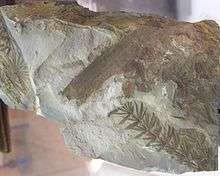Calamitaceae
Calamitaceae is an extinct family of plants related to the modern horsetails.[1] Some members of this family attained tree-like stature during the Carboniferous Period (around 360 to 300 million years ago) and in Permian Period, reaching heights of up to 20 meters. The family takes its name from its principal genus Calamites.
| Calamitaceae | |
|---|---|
 | |
| Annularia stellata | |
| Scientific classification | |
| Kingdom: | Plantae |
| Clade: | Tracheophytes |
| Class: | Polypodiopsida |
| Subclass: | Equisetidae |
| Order: | Equisetales |
| Family: | †Calamitaceae Unger, 1840 |
| Genera | |
|
See text | |
Because some proposed species are based on partial fossil records, it is not clear if these are merely different parts of the same type.
Proposed genera and species of Calamitaceae

Asterophyllites equisetiformis
- Annularia.
- A. stellata.
- Arthropitys.
- Asterophyllites (or incorrectly Asterophyllum).
- Astromyelon.
- Calamites.
- C. carinatus.
- C. suckowi.
- C. undulatus.
- Calamocarpon.
- Calamostachys.
- C. binneyana.
- Cingularia.
- Mazostachys.
- Paleostachya.
gollark: On my server with heavpøøøøøøøt.
gollark: Yep!
gollark: Muahahaha. I have made an automatic roboport deployer.
gollark: There is more to readability than comments, also.
gollark: Write me some readable Malbolge?
References
- Elgorriaga, A.; Escapa, I.H.; Rothwell, G.W.; Tomescu, A.M.F.; Cúneo, N.R. (2018). "Origin of Equisetum: Evolution of horsetails (Equisetales) within the major euphyllophyte clade Sphenopsida". American Journal of Botany. 105 (8): 1286–1303. doi:10.1002/ajb2.1125. PMID 30025163.
This article is issued from Wikipedia. The text is licensed under Creative Commons - Attribution - Sharealike. Additional terms may apply for the media files.